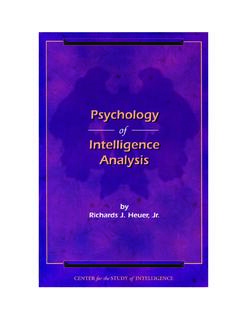Transcription of HOW MERITOCRACY IS DEFINED TODAY?: CONTEMPORARY …
1 Chang-Hee Kim, Yong-Beom Choi ISSN 2071-789X RECENT ISSUES IN SOCIOLOGICAL RESEARCH Economics & Sociology, Vol. 10, No. 1, 2017 112 Chang-Hee Kim, School of Management and Communication Republic Polytechnic, Singapore, Singapore, HOW MERITOCRACY IS DEFINED TODAY?: CONTEMPORARY ASPECTS OF MERITOCRACY E-mail: Yong-Beom Choi, Division of Social Welfare Baekseok Arts University, Seoul, Republic of Korea, E-mail: ABSTRACT. This study aimed to develop a deeper understanding of CONTEMPORARY aspects of MERITOCRACY based on a qualitative meta-synthesis of the scholarly literature. Eighteen empirical studies of MERITOCRACY in various disciplines were reviewed for this study.
2 Thematic analysis revealed three main higher-order themes with six sub-themes that described the characteristics of MERITOCRACY today. The findings present an overview of the current issues considered by MERITOCRACY studies and provide a foundation for the ongoing debate over the necessary conditions for a better MERITOCRACY . Received: July, 2016 1st Revision: October, 2016 Accepted: December, 2016 DOI: JEL Classification: D63, I24 Keywords: MERITOCRACY , equality of opportunity, qualitative meta-synthesis, thematic analysis, Singapore. 1. Introduction MERITOCRACY as a social system MERITOCRACY is a social system in which advancement in society is based on an individual s capabilities and merits rather than on the basis of family, wealth, or social background (Bellows, 2009; Castilla & Benard, 2010; Poocharoen & Brillantes, 2013; Imbroscio, 2016).
3 The idea of MERITOCRACY has received much attention since British sociologist Michael Young first coined the term in 1958. In particular, MERITOCRACY has increasingly been recognized as a positive system in Western societies, and the ideology has been tightly coupled with the notions of capitalism and egalitarian values, which are fundamental to the concept of the American Dream (Sealy, 2010). However, from a different viewpoint, a number of scholars (Bell, 2012; Poocharoen & Brillantes, 2013; Babcock & Freivogel, 2015; So, 2015; Zhang, 2015) have reported evidence that the initial concept of MERITOCRACY primarily emerged in Asia first, indicating an antecedent to the meritocratic practices of Western societies.
4 Hobson (2004) argued that the concept of merit initially started in China and came to the West via Confucian texts. In modern society, MERITOCRACY has allowed low status group members to dream about improving their social status, economic class, and place in the hierarchy, implanting the ideology that everyone has a chance of succeeding if they cultivate the required abilities Kim, C. H., Choi, Y. B. (2017), How MERITOCRACY is DEFINED Today?: CONTEMPORARY Aspects of MERITOCRACY , Economics and Sociology, Vol. 10, No. 1, pp. 112-121. DOI: Chang-Hee Kim, Yong-Beom Choi ISSN 2071-789X RECENT ISSUES IN SOCIOLOGICAL RESEARCH Economics & Sociology, Vol.
5 10, No. 1, 2017 113 (Wiederkehr et al., 2015). In this vein, MERITOCRACY has served as an engine of meritocratic upward mobility for maintaining social order and calming social unrest. As a governing principle, MERITOCRACY has also permeated a number of Asian countries that are heavily influenced by Confucianism, such as Singapore, Korea, and China. Correspondingly, studies of MERITOCRACY have been conducted in many different disciplines including business, public administration, education, psychology, and so forth, in an attempt to understand the social and cultural factors around us. MERITOCRACY today Much has changed since Young coined the term MERITOCRACY in 1958.
6 People around the world have undergone the harsh reality of ideological confrontations, globalization, financial crises, and the consequent inequality problems. In conjunction with recent salient events, people s beliefs about and perceptions of MERITOCRACY have fluctuated in society in recent years (Corbett, 2013; Reynolds & Xian, 2014; Newman et al., 2015). Accordingly, much of the current literature on MERITOCRACY pays particular attention to revisiting or redefining the concept (Young, 1998; Young, 2006; Pappas & Tremblay, 2010; Reyes, 2013; Reynolds & Xian, 2014; UNDP, 2015). Allen (2011) even claimed that the initial principles of MERITOCRACY had already changed, insisting that the system that Young originally described no longer exists.
7 In recent years, there has been a vigorous debate on what constitutes a correct, inclusive, and fair form of MERITOCRACY given the evolving sociopolitical circumstances in Singapore. What kind of MERITOCRACY are we witnessing at this moment? This study attempts to address this question. The authors argue that there is a substantial need for discussion and reflection on the CONTEMPORARY aspects of MERITOCRACY . Hence, the main purpose of this study is not to discover or provide another definition of MERITOCRACY ; rather, it is to describe several aspects and characteristics of MERITOCRACY today, based on a review of the descriptions found in the scholarly literature.
8 This comprehensive review is expected to enhance our understanding of MERITOCRACY and to stimulate a debate on the necessary conditions for CONTEMPORARY MERITOCRACY . 2. Methodology Selection of relevant articles To achieve this study s objective of describing the characteristics of CONTEMPORARY MERITOCRACY , a systemic review of studies of MERITOCRACY was conducted as follows. First, the authors used the keyword MERITOCRACY to search for relevant references on the Web of Science. Second, the selection of articles was restricted to peer-reviewed scholarly journal articles listed in the Social Science Citation Index; peer-reviewed scholarly journal articles with the phrase MERITOCRACY in the title; articles written in English; article using an empirical approach (qualitative or quantitative); and articles published between 2014 and 2016.
9 The articles in the Social Science Citation Index were used because the index is the traditional point of reference for this type of research analysis. The primary literature search identified 280 publications, 47 of which were published within the specified dates. A further 26 publications were excluded as they were not in the Social Science Citation Index, and 3 were excluded because they did not delineate the specific aspects of MERITOCRACY . Finally, 18 empirical studies reporting on MERITOCRACY in various disciplines were identified for this review. Chang-Hee Kim, Yong-Beom Choi ISSN 2071-789X RECENT ISSUES IN SOCIOLOGICAL RESEARCH Economics & Sociology, Vol.
10 10, No. 1, 2017 114 Analysis of the selected MERITOCRACY studies Thematic analysis was used as a qualitative meta-synthesis approach in this study. Thematic analysis is a method for identifying and analyzing patterns within qualitative data (Braun & Clarke, 2006). According to Noyes and Lewin (2011), thematic analysis is suitable for aggregating and summarizing qualitative data to address the research questions posed by researchers. Thematic analysis specifically provides an opportunity to code and categorize data into overarching themes from the initial data for analysis (Fereday & Muir-Cochrane, 2006).






